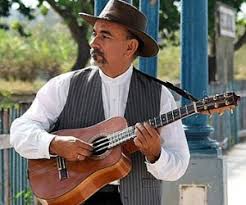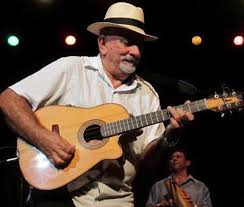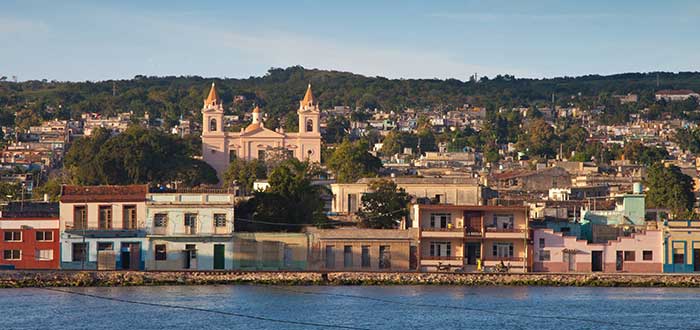 PANCHO AMAT, EL TRESERO MAYOR DEL SON CUBANO. VIDEOS.
PANCHO AMAT, EL TRESERO MAYOR DEL SON CUBANO. VIDEOS.
Francisco Amat Rodríguez, más conocido solo como Pancho Amat nació un 22 de abril de 1950 en Guira de Melena, la Habana, Cuba y es un músico cubano especializado en el tres, una guitarra o cordófono de tres tiempos de origen cubano. La variedad más extendida del instrumento es el original tres cubano de seis cuerdas y que comúnmente se toca en una variedad de géneros afrocubanos.
Cuentan que su madre, como oráculo precognitor, avizoró el futuro de su hijo y con su maternal pasión, descubrió que los sonidos que provenían de la radio -mientras su padre vendía carbón en las calles- le aquietaban. Le dio entonces el plato de latón y la cuchara, los cuales se convirtieron en sus primeros instrumentos. Luego, con apenas siete años, y como pago a la deuda de cierto cliente de su padre, recibió su primer tres.
Años más tarde llegaron a su vida, el repentista Herminio Pérez, quien enseñó los primeros acordes al niño en el barrio de La Vigía y la profesora de literatura Migdalia Martí, quien logró que su estudiante se interesara por las artes en general.
Abierto al mundo que se le mostraba, se vinculó al conjunto de sones de la fábrica de tabacos “Montero” en su localidad, y al grupo de guaguancó, dirigido por el gran tamborero Sixto Sotolongo, para seguidamente dar un salto inesperado en su formación que lo llevó a ser profesor de Química y Física, siempre sin alejarse de sus amadas cuerdas.
Luego, en la Universidad de La Habana, donde se licenció en pedagogía en 1971, junto a músicos del Grupo Moncada, Pancho formó lo que se convertiría en Manguaré al tiempo que estudiaba en el Conservatorio Ignacio Cervantes.
En 1971, como miembro del Grupo Manguaré, se convertirían en uno de los conjuntos líderes dentro del movimiento de la nueva trova. Posteriormente tocó en Adalberto Álvarez y su Son. Actualmente es el líder de su propio grupo, El Cabildo del Son.
https://youtu.be/7QhEOFs5vLo
En 2010, ganó el Premio Nacional de Música otorgado por el Instituto Cubano de Música.
Ha trabajado en tríos, cuartetos, conjuntos, charangas, incluso haciendo arreglos para orquesta sinfónica. Ha colaborado con artistas como Joaquín Sabina, Oscar D’León, Pablo Milanés, Rosana, Ry Cooder, Silvio Rodríguez, Víctor Víctor, Yomo Toro y Víctor Jara, y ha trabajado con el rockero español Santiago Auserón en el proyecto Juan Perro. Ha realizado giras por Estados Unidos, Europa y Japón con diferentes grupos de música cubana.
En 1995 estrenó ‘Son Por Tres’, que ganó el Premio Nacional de la Crítica en Cubadisco. Su segunda producción, ‘De San Antonio a Maisí’. fue galardonado con el premio Cubadisco 2002 al Mejor Álbum de Música Tradicional.
Pancho Amat es seguidor en Cuba de la obra de famosos tres intérpretes como Arsenio Rodríguez. Va de tresero a compositor, de arreglista a director de agrupación, y se pueden encontrar en su obra elementos clásicos, cadencias del pop o el rock, y hasta del jazz.
En noviembre de 2012 fue seleccionado para la inauguración de la decimosexta versión del DR Jazz Festival, junto a importantes figuras de la cuerda caribeña como el guitarrista Juan Francisco Ordóñez y el “cuatroista” Pedro Guzmán, entre otros.
Leonel Francisco Amat, Premio Nacional de la Música 2010, aseguró en una ocasión “Creo que si no hubiera sido tresero, sería el más triste de todos los hombres”.
Asi habla el merecedor del premio Maestro de juventudes, que otorga la Asociación Hermanos Saíz, pues además de ser el máximo exponente en la isla de la guitarra cubana conocida como tres, se ha convertido en formador incansable de las nuevas generaciones.
 PANCHO AMAT, THE GREATEST “TRESERO” OF THE CUBAN SON. VIDEOS.
PANCHO AMAT, THE GREATEST “TRESERO” OF THE CUBAN SON. VIDEOS.
Francisco Amat Rodríguez, better known only as Pancho Amat, was born on April 22, 1950, in Guira de Melena, Havana, Cuba and is a Cuban musician specialized in tres, a three-beat guitar or chordophone of Cuban origin. The most widespread variety of the instrument is the original six-string Cuban tres and is commonly played in a variety of Afro-Cuban genres.
They say that his mother, as a precognitive oracle, foresaw the future of her son and with her motherly passion, discovered that the sounds that came from the radio – while his father sold coal in the streets – quieted him. He then gave him the brass plate and spoon, which became his first instrument. Then, at just seven years old, and as a payment to the debt of a certain client of his father, he received his first three.
Years later, the repentista Herminio Pérez came into his life, who taught the first chords to the child in the neighborhood of La Vigía and the literature teacher Migdalia Martí, who made her student take an interest in the arts in general.
Open to the world that was shown to him, he joined the group of sones from the “Montero” tobacco factory in his town, and the guaguancó group, led by the great drummer Sixto Sotolongo, to then take an unexpected leap in his training that It led him to be a professor of Chemistry and Physics, always without straying from his beloved strings.
Later, at the University of Havana, where he graduated in pedagogy in 1971, together with musicians from the Moncada Group, Pancho formed what would become Manguaré while studying at the Ignacio Cervantes Conservatory.
In 1971, as a member of the Manguaré Group, they became one of the leading groups within the Nueva Trova movement. Later he played in Adalberto Álvarez y su Son. He is currently the leader of his own group, El Cabildo del Son.
In 2010, he won the National Music Prize awarded by the Cuban Institute of Music.
He has worked in trios, quartets, ensembles, brass bands, even arranging for symphony orchestra. He has collaborated with artists such as Joaquín Sabina, Oscar D’León, Pablo Milanés, Rosana, Ry Cooder, Silvio Rodríguez, Víctor Víctor, Yomo Toro and Víctor Jara, and has worked with Spanish rocker Santiago Auserón on the Juan Perro project. He has toured the United States, Europe and Japan with different Cuban music groups.
In 1995 he premiered ‘Son Por Tres’, which won the National Critics Award at Cubadisco. His second production, ‘De San Antonio a Maisí’. was awarded the 2002 Cubadisco award for Best Traditional Music Album.
Pancho Amat is a follower in Cuba of the work of famous three interpreters such as Arsenio Rodríguez. He goes from tresero to composer, from arranger to band director, and you can find in his work classical elements, cadences of pop or rock, and even jazz.
In November 2012 he was selected for the inauguration of the sixteenth version of the DR Jazz Festival, together with important figures of the Caribbean string such as guitarist Juan Francisco Ordóñez and “cuatro player” Pedro Guzmán, among others.
Leonel Francisco Amat, National Music Prize 2010, said on one occasion “I think that if I had not been tresero, I would be the saddest of all men.”
So speaks the recipient of the Master of Youth award, awarded by the Hermanos Saíz Association, because in addition to being the greatest exponent on the island of the Cuban guitar known as tres, he has become a tireless educator of the new generations.
Agencies/ Wiki/ RadioEncyclop/ Internet Photos/ YouTube/ Arnoldo Varona/ www.TheCubanHistory.com
THE CUBAN HISTORY, HOLLYWOOD.



 PANCHO AMAT, el Tresero Mayor del Son Cubano. VIDEOS.
PANCHO AMAT, el Tresero Mayor del Son Cubano. VIDEOS.





